Blog = back-log. So says my friend, Carl Galdstone. And I’ve read so many books since I wrote my last review that I’m going to try something new: Good Reads. Here’s my Good Reads list.
Networking for People Who Hate Networking
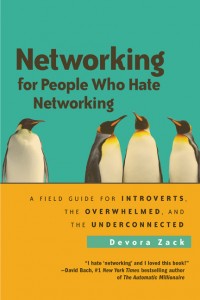 Networking for People Who Hate Networking: A Field Guide for Introverts, the Overwhelmed, and the Underconnected
Networking for People Who Hate Networking: A Field Guide for Introverts, the Overwhelmed, and the Underconnected
By Devora Zack
Rating: 7 of 10
Thanks to Devora Zack, I’ve realized something about myself. I’m not an introvert. I’m what she calls a “centrovert.” The distinction is very helpful. If you’re familiar with the Meyers Briggs personality type inventory you will know that there is a scale that ranges from one side, introvert, to the other side, extrovert. When I have taken the inventory in the past, I tend to fall in the middle toward the introvert side. I have always claimed that I’m an introvert. But Devora points out that people in the middle are better called “centroverts.” The reality for me is that I can put on a lot of extrovert skills when needed, but they tend to wear me out over time.
Sometimes I look like an extrovert, especially if you come to church on Sunday morning. But Devora points out that introverts think to talk (they’re reflective), they go deep (they’re focused), and they energize alone (they’re self-reliant). This pretty much nails me most of the time. On the other hand extroverts talk to think (they’re verbal), they’re expansive (range widely), and they energize with others (they’re social).
Devora points out that networking books tend to cater to extroverts. Her book is different. She outlines a very helpful set of guidelines that play to introverts strengths. Here’s a list of old rules for networking that play to extroverts and new rules that play to introverts:
Old Rule: Jump on in (Patter)
New Rule: Pause (Plan for networking)
Old Rule: Sell yourself (Promote)
New Rule: Process (Go deep to connect)
Old Rule: Maximize time with others (Party)
New Rule: Pace (Know when to withdraw to energize)
Devora then runs these three new rules through several different settings that people often find themselves in such as a conference, hunting for a job, business travel, or at a networking event. Her best example from her own experience was from a conference she personally attended.
Pause: She researched all the publishers who would be there. Of the hundreds she found two or three that fit the kind of book she wanted to write.
Process: She narrowed her list down to one and set up a meeting with that one publisher and connected deeply by being very well prepared for that one meeting.
Pace: She didn’t meet with any of the other publishers. She brought all her energy to that one meeting. She didn’t try to promote herself everywhere. She paced her energy.
The result was the book I read. Most people would think that to get a book published you have to get it out to as many publishers as possible, and this may work sometimes. But my own experience watching my wife (who is probably a “centrovert” on the extrovert side) write and publish is that she does best when she narrows her ideas down to very specific publishers and works to build a lasting relationship with those publishers.
So here’s how I’m taking this into my next conference setting. I just attended a second pastors conference in Florida. I decided to PAUSE and do some advanced planning. I emailed the co-organizer and described myself (I actually already new him) and my situation as a second pastor. I asked him if he knew any other second pastors who were in similar situations that I might begin to connect with on Facebook or via email. That way when I showed up I had one or two people I already knew rather than walking cold into a room of people I don’t know. He wasn’t in charge of registration so he didn’t know who was registered. I suggested we set up a Facebook page/group before the conference for people who were attending the conference. He liked the idea and made it happen. When I arrived I paid attention to making some significant lasting connections (PROCESS) with a couple of people and PACED myself and my relational energy by going to a movie one night by myself. Zack’s ideas helped me navigate this conference in an intentional way that played to my strengths.
Ten Lessons to Transform Your Marriage by John & Julie Gottman
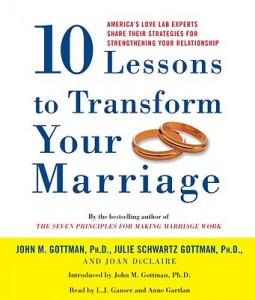 Ten Lessons to Transform Your Marriage
Ten Lessons to Transform Your Marriage
By John & Julie Gottman
Rating: 8 of 10
I first heard about the Gottmans while listening to Malcolm Gladwell’s book Blink. Gladwell described them as relationship experts who after briefly listening to a couple argue could predict whether they would be together or not in seven years with 90% accuracy! That got my attention. It turns out that there are four “horsemen” that the Gottmans look for: criticism, stonewalling, defensiveness, and contempt. If one of these behaviors shows up in an argument (especially contempt), your relationship is unlikely to have a happy future.
Ten Lessons is the Gottman’s positive take on their negative research: what can couples do to enhance their relationship and dismount the four horsemen? What makes this book so engaging is that the ten lessons are ten different scenarios that regularly come up in many relationships and are explored through verbatim conversations with real-life couples. These ten lessons range from addiction to work and healing form an affair to lack of passion and nagging. Anyone deal with those issues in their marriage?
In each chapter the Gottmans introduce you to a new couple and their argument. The verbatims are like sitting in on a real-life counseling session. You hear how the couples discuss and argue. Then the Gottmans do some teaching and training on how to have the conversation in a different way with tips like, “How to complain without criticizing,” and then the couples give the conflict another go around. It is fascinating to see how a conflict that had deep ruts built over years and years of arguing can actually change course.
I liked this book and the Gottman’s take on marriage so much that Sarah and I have decided to use their home-retreat package for a personal home workshop on our fifteenth anniversary. The box, which arrived in the mail last week, comes with DVDs, two workbooks, and several cards for exercises. We’ve scheduled a two-day two-night getaway at an historic inn that also has a DVD player and comfy chairs in the room. Given that Sarah and I have made it to fifteen years, I don’t think we’re in any danger of failing the Gottman’s seven-year prediction test, but that doesn’t mean that we don’t still have things to learn about loving one another better. If Ten Lessons is any indication of what we’re in for, then our commitment, connection, and love for one another will learn even more lessons over this marriage getaway.
Fascinate: Your 7 Triggers to Persuasion and Captivation by Sally Hogshead
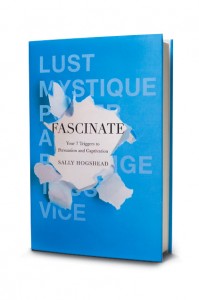 Fascinate: Your 7 Triggers to Persuasion and Captivation
Fascinate: Your 7 Triggers to Persuasion and Captivation
By Sally Hogshead
Rating: 6 of 10
How do you hold people’s attention by fascinating them more? That’s the question Hogshead tries to answer in her book, Fascinate. Fascinate is essentially a book about marketing. Hogshead points out that her research has shown that people are willing to pay more to be fascinated. She sees this as a marketing tool that companies can explore to gain and hold the attention of possible customers.
Hogshead describes seven triggers to fascination: power, prestige, mystique, passion, alarm, rebellion, and trust. You can take an inventory online www.howtofascinate.com and learn what your top two natural triggers are, your “F Score.” (When I took the test several months ago it was free, but now it costs $17.)
My primary trigger is “power,” and my secondary trigger is “trust.” My dormant trigger is “rebellion.” Here are a couple of sentences from the profile description of each:
Power – “You’re a natural leader, and comfortable with authority, making you well-suited to creating messages that inspire large groups.”
Trust – “You’re stable, reliable, and you relax others with your steady personality. you don’t like feeling off-kilter, and work hard to achieve consistency. Over and over, you let people know they can count on you.”
Rebellion – “Yet consider how rebellion might improve your thinking. A dash of irreverence and curiosity sparks fresh creative thinking. This trigger encourages people to break out of strict norms and find more innovative solutions.”
I found the dormant trigger information more helpful than the dominate triggers. Hogshead did get me thinking how as a communicator I might tweak my communication style to hold the attention of groups of people more fully. I’ve continued thinking more about how I might add some rebellion into my thinking and speaking. Lately, our church has unveiled a vision for developing seven satellites in seven venues on seven days of the week. Perhaps this is a bit of the rebellion trigger coming out. This vision isn’t satisfied with keeping the steady hum of the status quo. At the same time, it’s a little breathtaking. All rebels aboard!
The Excalibur Murders by J.M.C. Blair
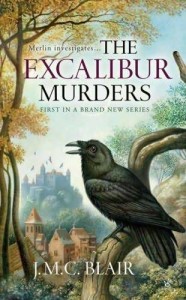 The Excalibur Murders
The Excalibur Murders
By J.M.C. Blair
Rating: 6 of 10
Here’s the premise: Merlin isn’t a wizard, he’s a modern day detective-scholar. When several murders seemingly related to the supernatural rock the halls of Camelot and threaten to undermine King Arthur’s authority, Merlin and his band of students work to uncover the true natural story of what happened. What they find is a plot to overthrow Arthur. All of this sounds spectacular, and that’s why I picked up the book from the new bookshelves of the library. But the execution of the story telling left me wanting more.
I’ve begun to notice something in several books I’ve read lately (Caleb’s Crossing being the most obvious other example). Authors seem to put modern people with all their modern sensibilities into ancient settings as a way of providing contrast to tell a story and move the plot forward. In the case of Caleb’s Crossing, which recently won a Christianity Today book-of-the-year award, the main character, Bethia, often sounds like a modern woman thrown into the early colonial period. The contrast helps magnify the differences between then and now, but the character seems less than believable.
The same is true of Merlin in The Excalibur Murders. He is a modern skeptic of the supernatural trying to bring education and reason to a land dominated by superstition. I suspect there were truly people ahead of their time in the ancient world, but I would guess that they were a little less different and a little more complicated than either of these authors makes their protagonist out to be. For example Merlin could have had one superstition that he did believe in. That would have made him seem more like a realistic character of the day.
This ongoing issue I have with modern writers putting modern sensibilities into ancient times aside, I’ll probably still pick up the next book in The Excalibur Murders series. It was still entertaining to read.
Blood of Brothers by Stephen Kinzer
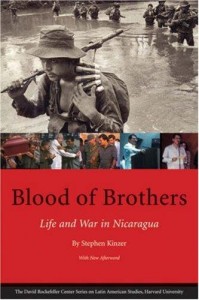 Blood of Brothers: Life and War in Nicaragua
Blood of Brothers: Life and War in Nicaragua
By Stephen Kinzer
Rating: 7 of 10
I recently went on a medical mission trip to Nicaragua with a team from my church. When I travel to other countries, I usually like to pick up a book on the history of the place I am visiting so that I have a bigger context for the culture, politics, and people I will meet. Blood of Brothers was the only history of Nicaragua that I found through our local library system, and it tells the story of the Sandinsta and Contra civil war during the 1980s.
Stephen Kinzer was the bureau chief for The New York Times living in Nicaragua during the civil war, so he comes to the telling of this story not so much as an “objective” and “uninterested” academic studying the topic from abroad, but as someone who lived through it all first-hand. His personal experience helps make the book more readable, and at times it comes across more as a memoir than a journalistic endeavor.
The rise of the Sandinistas took place in 1979 when I was four-years-old. The Contra war raged through the 1980s while I was growing up. Many of the names are familiar to me having heard them through the 80s, but most of the stories and the meanings behind them were lost to me until I read this book. Here’s the super short history of the time period that Kinzer fleshes out so well.
For forty years the Somoza family led Nicaragua as dictators, squeezing the people and the economy for personal gain. In the late 1970s, after decades of organizing, the Sandinistas overthrew Anastasio Somoza Debayle, the most brutal of all the Somoza dictators, and came to power. The Sandinistas, taking their name after a Nicaraguan leader named Sandino who fought against U.S. Marines in the 1800s, were a Marxist/Communist revolutionary front with ties to Cuba, the U.S.S.R, North Korea, and the like. Daniel Ortega eventually rose to prominence in the Sandinista political structure.
When Ronald Regan was elected president, he saw the Sandinistas and their rise to power as a significant part of the Cold War. Regan was determined not to let communism gain a foothold in Central America, so the CIA began supporting the Somoza military leadership that was in exile primarily in Florida. With the backing of the CIA, these ex-guardsmen took up arms in a contra-revolution based primarily out of Honduras on the Northern border of Nicaragua.
This civil war lasted for a decade and drained Nicaragua of most of its resources. While the Sandinistas made some poor political choices, they also never had a chance to actually govern without preparing for an expected U.S. invasion of Nicaragua that never actually happened. The country’s economy spiraled downward, but was propped up in large part by aid from Cuba, the U.S.S.R., and other countries.
When the Cold War ended with the fall of the U.S.S.R., the Sandinistas no longer had the financial backing to continue the war, and the U.S. also lost some of its interest in financially supporting the contras. The Costa Rican president, Oscar Arias, presented a Central American treaty that helped broker a cease-fire and eventual reintegration of the contras into Nicaraguan political life. This treaty included an election, which in 1990 saw Daniel Ortega lose unexpectedly to Violeta Chamorro, the widow of an anti-Samoza and anti-Sandinista newspaper, whose founder, Pedro Chamorro, was killed ten years earlier for his political views.
Besides getting an in-depth understanding of recent Nicaraguan history, I also gained a better understanding for how United States foreign policy can wreak havoc on a small country. I can’t help wondering if there was a better way to engage communism in Central America than supporting a civil-war that decimated a country and its people. U.S. intervention in Nicaragua also sounds very similar to modern-day intervention in the Middle East. Will our foreign policy in the Middle East and other hot spots in the world look as misguided in twenty years from now as our efforts in Nicaragua in the 1980s look today? Time will tell.
For pictures from my recent trip to Nicaragua click here.
Sticky Teams by Larry Osborn
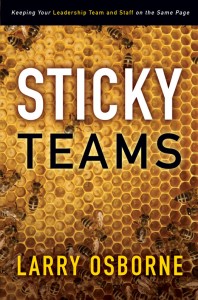 Sticky Teams
Sticky Teams
by Larry Osborne
Rating: 8 of 10
Larry Osborn suggests that unity of the leadership team is the most fundamental leadership task that a pastor has to accomplish. To this end he gives the church leader a very practical resource for how to develop a unified and thriving church leadership team.
There are many practical suggestions I found helpful in this book, but one that really “stuck” to me was the difference between lobbying and continuing education. Osborn points out that if there is not an ongoing continuing education program for a leadership team, then any educational pieces given in the moment of decision-making will come across as lobbying and are likely to be received with skepticism. To accomplish this kind of continuing education, he suggests that a leadership team needs to meet more often, perhaps twice a month, with one meeting being devoted entirely to continuing education.
All My Holy Mountain by L.B. Graham
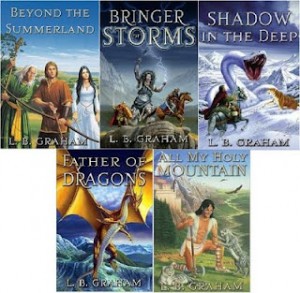 All My Holy Mountain
All My Holy Mountain
The Binding of the Blade Book 5
By L.B. Graham
Rating: 7 of 10
I picked up the first book in this series about five or six years ago and read the first four before heading off to seminary and before the fifth book was published. I’m finally now picking the series back up and finishing it. I became familiar with the book because Sarah was a fellow student with L.B. Graham at Wheaton College. He is currently the chair of the Bible department and teacher of English and ethics at Westminster Christian Academy in St. Louis.
Direct Hit by Paul Borden
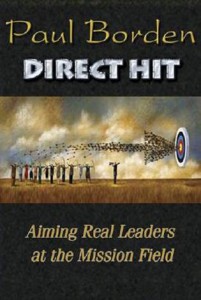 Direct Hit
Direct Hit
By Paul Borden
Rating: 7 of 10
Direct Hit is the second book in a series of books that pastors and laity are reading together in the Vital Church Initiative of the West Michigan Conference and Lansing District. Borden outlines what he sees as the essentials for turning churches around from dying to thriving. Borden, an American Baptist, is the original architect of the system that is being put in place for the Vital Church Initiative although it is being adapted to fit the United Methodist Church.
There are many ideas in this book that jumped out at me. First, Borden highlights just how much visioning time is given to the pastor. He points out that pastors are given twenty to thirty minutes every week to speak vision into the life of a community. People come expecting to hear it. Even beyond this time there are board meetings, staff meetings, and one-on-one meetings. He asks pastors to consider how effective and strategic they’re being at using that time wisely. I’ve begun to notice how there is a time before worship every week when my morning volunteers gather to walk through the morning and how ripe this time is for casting vision. I have begun to use it as such.
Second, Borden points out the importance of the pastor creating a healthy sense of urgency. My own personality and worldview tends away from alarmism, but Borden has convicted me to insert a little more alarm into my visioning time. At the same time, Borden uses so much militaristic language in this book that I wouldn’t mind if he turned down a bit his own urgency dial.
Third, Borden introduces George Bullard’s lifecycles of a church. It begins with birth where vision is high and ends with death where maintenance is all that is left. In between are varying times of emphasizing relationships and programs. A healthy community needs to cycle back to the beginning and be reborn every five to seven years. I’ve been using this idea lately during my pre-worship team meetings to help insert a sense of urgency in our church’s culture. People may disagree with where we are at in this cycle, but everyone understands that for us to remain thriving as we head into the future, we must recreate ourselves with new vision.
Fourth, Borden outlines the process that is being used for the Vital Church Initiative. This process has been most effectively adapted and used in the Missouri Conference of The United Methodist Church. The West Michigan Conference is learning it from Missouri. It includes a year of reading books together, a time of evaluation by an outside consultant, the creation of a prescription for vitality, a vote by the church, and the assignment of a coach if the church votes to adopt the prescription for vitality. This process may be the most effective I have seen at making a significant amount of change in a relatively short period of time.
Currently Reading/Listening
The Busy Family’s Guide to Spirituality by David Robinson
Parenting with Purpose by Oddbjorn Evenshaug, Dag Hallen, and Roland Martinson
At the Still Point compiled by Sarah Arthur
Shaped By God’s Heart: The Passion and Practices of Missional Churches by Milfred Minatrea
Roman Lives by Plutarch
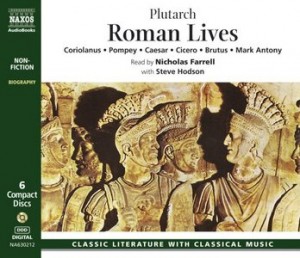 Roman Lives
Roman Lives
By Plutarch
Rating: 6 of 10
If you’re a history buff you will love this book. If you’re not, well, probably not. I picked up this audio book after reading Robert Harris’ novels about Cicero, Imperium and Conspirata. Harris made me curious to know how much of what he wrote about Cicero was historical and how much was fiction. I was surprised to find that the general thrust of Harris’ portrayal of Cicero was quite historical. Plutarch may have even been a source for Harris’ writing. Plutarch is a late first century and early second century historian. Roman Lives focuses on the lives of Coriolanus (I skipped over), Pompey, Caesar, Cicero, Brutus, and Mark Antony.
While I did not go into this book looking for historical background for the New Testament, I found that Plutarch has helped expand my imagination for the broader culture of the region within which sits the authors and characters of the New Testament. For example the Biblical book of Revelation speaks in symbolic images about the threat that the Roman Empire (or any empire) poses to following Jesus faithfully. Roman Lives fleshed out that threat by giving me a better perspective on just how much war, violence, and general immorality were caused by figures like Pompey, Caesar, Brutus, and Mark Antony warring their ego’s against one another on the battlefields of the Mediterranean. Interestingly enough, Cicero seems to be a fairly moral leader amidst these others, and Harris portrays him as such in his historical novels.
The comparison between the Roman Empire and The United States has been made several times, but after reading Roman Lives I am struck by the parallels between the time of the dissolution of the Roman Republic and our own current political situation. We are living in frighteningly similar times. This should, I think, cause we Americans to have a bit of humility when it comes to our engagement with both the rest of the world and our potential historical legacy. In its day, who would have thought that the Roman Empire would cease to exist? And in our day, who can imagine The United States ceasing to exist? This humbling reality drives me to seek my primary identity and citizenship in another kingdom, the kingdom of heaven.
Currently Reading/Listening
The Busy Family’s Guide to Spirituality by David Robinson
Parenting with Purpose by Oddbjorn Evenshaug, Dag Hallen, and Roland Martinson
At the Still Point compiled by Sarah Arthur
Sticky Teams by Larry Osborn
Fascinate by Sally Hogshead
Direct Hit: Aiming Real Leaders at the Mission Field by Paul Borden
Shaped By God’s Heart: The Passion and Practices of Missional Churches by Milfred Minatrea

Recent Comments